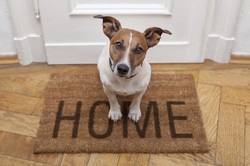HOME VISIT CHECKLIST (to do BEFORE placement in a new home)

It is critical to plan to visit a new possible home prior to finalizing an adoption. This will help ensure the home is a match for the rescued dog and ALSO verify the honesty of the interested person or family.
1). Bring Fido with you and make sure all family members or residence of the home are present.
2). Watch how the people interact with Fido and visa versa. Are they affectionate, loving, relaxed or nervous and worried about where the dog wanders.
3). Ask to see where Fido will sleep at night. Crate? Bed? Basement? Outdoor pen? It is very important for the family to be "OK" with the new dog sleeping where they sleep because they are pack animals, whether it be on their own bed or the persons bed. If a crate is needed, it should be with the family and only until the dog has learned the rules and routine and can be trusted.
4). Look for a full water bowl if they have other animals already in the home.
5). Inspect the backyard and fence. Make sure the fence has no escape routes. If the family plans to exercise ALOT, walking and dog park visits, a tie out if yard is not fenced may be acceptable but a cable run is much better. Check for old chains and dirt area or holes in the area surrounding an old chain. This is evidence of a previous dog being chained out excessively and should NOT acceptable as a good home.
6). Watch kids and the interaction. If they are rough or teasing the dog, this is not a good match and could endanger the dogs life or evoke a bite.
7). Follow your instincts. Listen to your gut feeling. If you don't feel good about placement of the dog than you probably shouldn't. Remember...you should be picky and never settle. This decision will affect the dogs life, forever.
8) if you decide this home is a good match, plan to keep in touch with the new home to verify things are going ok and to also offer help should they need it. It's better to keep tabs on things than to get a phone call that they are dumping the dog. Most challenges that a new home may be experiencing can be resolved with support from you or a positive reinforcement trainer.
1). Bring Fido with you and make sure all family members or residence of the home are present.
2). Watch how the people interact with Fido and visa versa. Are they affectionate, loving, relaxed or nervous and worried about where the dog wanders.
3). Ask to see where Fido will sleep at night. Crate? Bed? Basement? Outdoor pen? It is very important for the family to be "OK" with the new dog sleeping where they sleep because they are pack animals, whether it be on their own bed or the persons bed. If a crate is needed, it should be with the family and only until the dog has learned the rules and routine and can be trusted.
4). Look for a full water bowl if they have other animals already in the home.
5). Inspect the backyard and fence. Make sure the fence has no escape routes. If the family plans to exercise ALOT, walking and dog park visits, a tie out if yard is not fenced may be acceptable but a cable run is much better. Check for old chains and dirt area or holes in the area surrounding an old chain. This is evidence of a previous dog being chained out excessively and should NOT acceptable as a good home.
6). Watch kids and the interaction. If they are rough or teasing the dog, this is not a good match and could endanger the dogs life or evoke a bite.
7). Follow your instincts. Listen to your gut feeling. If you don't feel good about placement of the dog than you probably shouldn't. Remember...you should be picky and never settle. This decision will affect the dogs life, forever.
8) if you decide this home is a good match, plan to keep in touch with the new home to verify things are going ok and to also offer help should they need it. It's better to keep tabs on things than to get a phone call that they are dumping the dog. Most challenges that a new home may be experiencing can be resolved with support from you or a positive reinforcement trainer.

